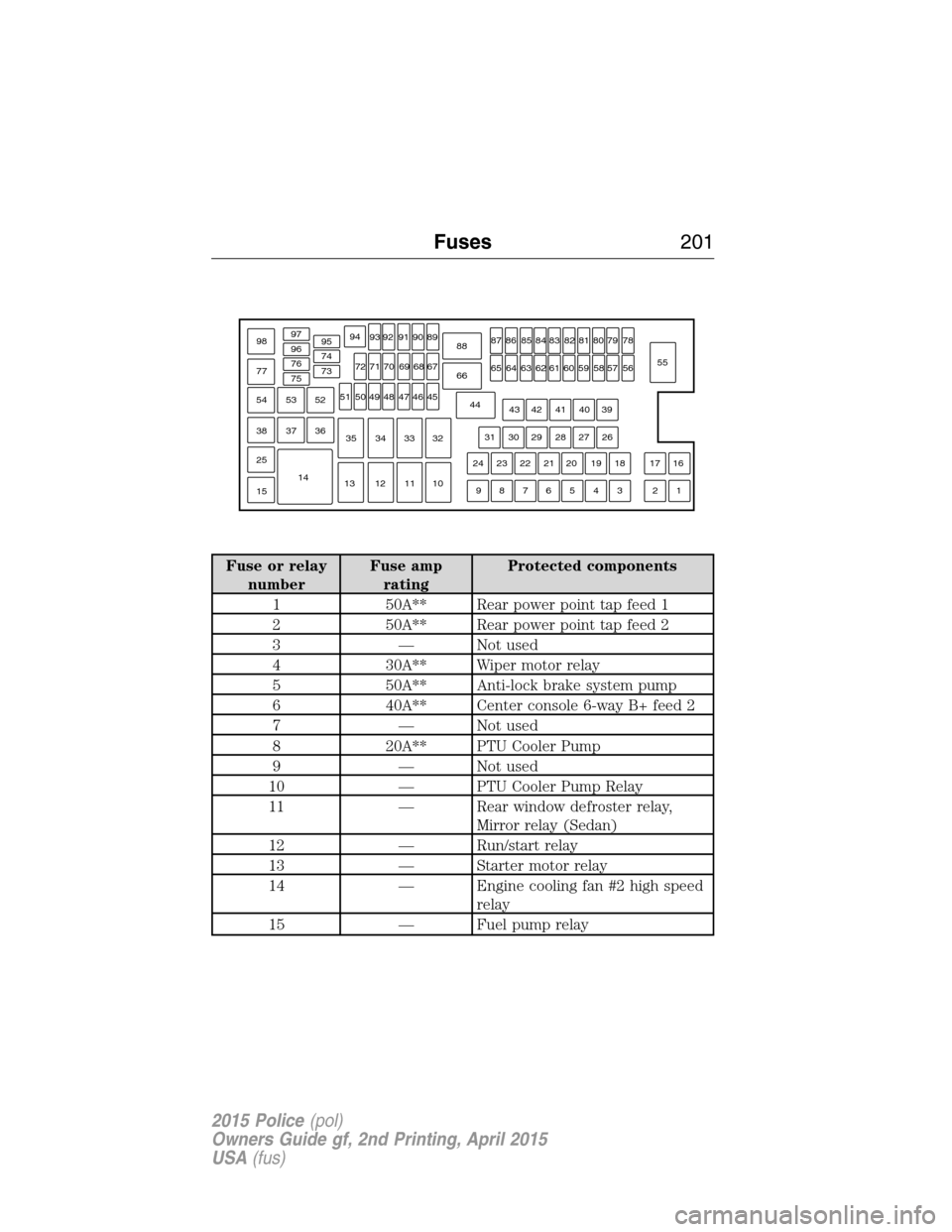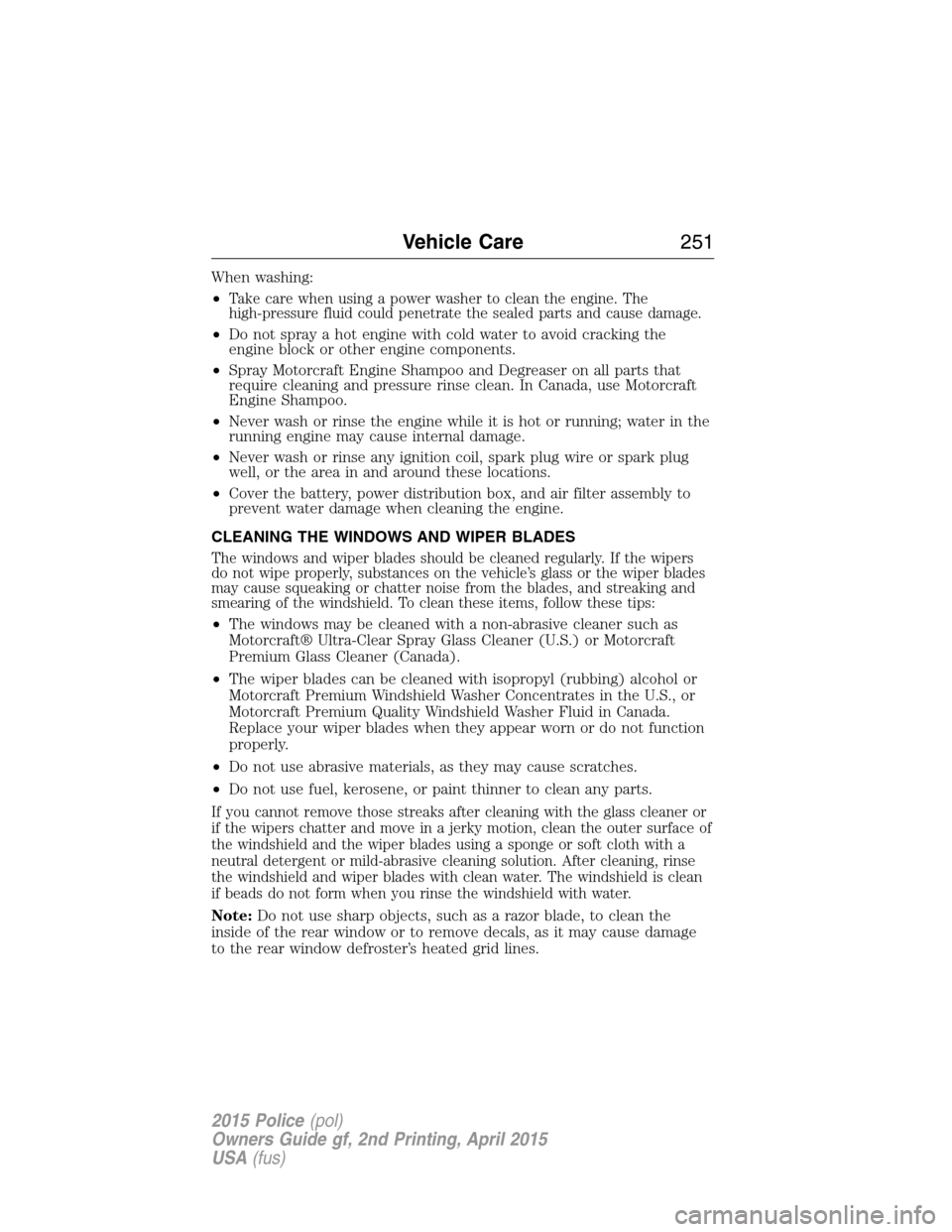2015 FORD POLICE INTERCEPTOR SEDAN Defroster
[x] Cancel search: DefrosterPage 4 of 401

Climate Control 107
Manual heating and air conditioning........................107
Rear window defroster.................................108
Cabin air filter.......................................109
Seats 110
Sitting in the correct position............................110
Head restraints.......................................111
Manual seats........................................113
Power seats.........................................114
Rear seats..........................................115
Auxiliary Power Points 117
Storage Compartments 118
Center console.......................................118
Overhead console.....................................119
Starting and Stopping the Engine 120
Ignition switch.......................................121
Starting the engine....................................121
Engine block heater...................................124
Fuel and Refueling 126
Fuel quality.........................................127
Running out of fuel....................................128
Refueling...........................................130
Fuel consumption.....................................132
Transmission 137
Automatic transmission.................................137
All-Wheel Drive (If Equipped) 139
All wheel drive.......................................139
Table of Contents3
2015 Police(pol)
Owners Guide gf, 2nd Printing, April 2015
USA(fus)
Page 184 of 401

BREAKING-IN
You need to break in new tires for approximately 300 miles
(480 kilometers). During this time, your vehicle may exhibit some unique
driving characteristics. Avoid driving too fast during the first 1000 miles
(1600 kilometers). Vary your speed frequently and change up through
the gears early. Do not labor the engine. Do not tow during the first
1000 miles (1600 kilometers).
ECONOMICAL DRIVING
Fuel economy is affected by several things, such as how you drive, the
conditions you drive under and how you maintain your vehicle.
There are some things to keep in mind that may improve your fuel
economy:
•Accelerate and slow down in a smooth, moderate fashion.
•Drive at steady speeds without stopping.
•Anticipate stops; slowing down may eliminate the need to stop.
•Combine errands and minimize stop-and-go driving.
•Close the windows for high-speed driving.
•Drive at reasonable speeds (traveling at 55 mph [88 km/h] uses 15%
less fuel than traveling at 65 mph [105 km/h]).
•Keep the tires properly inflated and use only the recommended size.
•Use the recommended engine oil.
•Perform all regularly scheduled maintenance.
There are also some things you may not want to do because they may
reduce your fuel economy:
•Sudden or hard accelerations.
•Rev the engine before turning it off.
•Idle for periods longer than one minute.
•Warm up your vehicle on cold mornings.
•Use the air conditioner or front defroster.
•Use the speed control in hilly terrain.
•Rest your foot on the brake pedal while driving.
•Drive a heavily loaded vehicle or tow a trailer.
Driving Hints183
2015 Police(pol)
Owners Guide gf, 2nd Printing, April 2015
USA(fus)
Page 202 of 401

Fuse or relay
numberFuse amp
ratingProtected components
1 50A** Rear power point tap feed 1
2 50A** Rear power point tap feed 2
3 — Not used
4 30A** Wiper motor relay
5 50A** Anti-lock brake system pump
6 40A** Center console 6-way B+ feed 2
7 — Not used
8 20A** PTU Cooler Pump
9 — Not used
10 — PTU Cooler Pump Relay
11 — Rear window defroster relay,
Mirror relay (Sedan)
12 — Run/start relay
13 — Starter motor relay
14 — Engine cooling fan #2 high speed
relay
15 — Fuel pump relay
97
98
77969594
93 92 91 90 89
88
66
4478
56
39
26
18 1617
312 4 5 6 7 8 919 20 21 22 23 2427 28 29 30 3140 41 42 4355
57 58 59 60 61 62 63 64 6579 80 81 82 83 84 85 86 87
67
45
32
10 11 12 1333 34 3546 47 48 49 50 5168 69 70 71 72 74
73 76
75
53
37 36 54
38
25
151452
Fuses201
2015 Police(pol)
Owners Guide gf, 2nd Printing, April 2015
USA(fus)
Page 206 of 401

Fuse or relay
numberFuse amp
ratingProtected components
81 20A* Spot lights
82 15A* Rear washer (Utility)
83 — Not used
84 20A* Trailer tow park lamps (Utility)
85 — Not used
86 7.5A* Powertrain control module
keep-alive power and relay,
Canister vent solenoid
87 5A* Run/start relay coil
88 — Run/start relay
89 5A* Front blower relay coil, Electrical
power assist steering module
90 10A* Powertrain control module
run/start
91 — Not used
92 10A* Anti-lock brake system module
93 5A* Rear window defroster relay,
Run/start relay, Trunk release
relay
94 30A** Passenger compartment fuse
panel run/start
95 2A* Center console start feed
96 — Not used
97 — Not used
98 — Air conditioner clutch relay
*Mini Fuses **Cartridge Fuses
Fuses205
2015 Police(pol)
Owners Guide gf, 2nd Printing, April 2015
USA(fus)
Page 252 of 401

When washing:
•
Take care when using a power washer to clean the engine. The
high-pressure fluid could penetrate the sealed parts and cause damage.
•Do not spray a hot engine with cold water to avoid cracking the
engine block or other engine components.
•Spray Motorcraft Engine Shampoo and Degreaser on all parts that
require cleaning and pressure rinse clean. In Canada, use Motorcraft
Engine Shampoo.
•Never wash or rinse the engine while it is hot or running; water in the
running engine may cause internal damage.
•Never wash or rinse any ignition coil, spark plug wire or spark plug
well, or the area in and around these locations.
•Cover the battery, power distribution box, and air filter assembly to
prevent water damage when cleaning the engine.
CLEANING THE WINDOWS AND WIPER BLADES
The windows and wiper blades should be cleaned regularly. If the wipers
do not wipe properly, substances on the vehicle’s glass or the wiper blades
may cause squeaking or chatter noise from the blades, and streaking and
smearing of the windshield. To clean these items, follow these tips:
•The windows may be cleaned with a non-abrasive cleaner such as
Motorcraft® Ultra-Clear Spray Glass Cleaner (U.S.) or Motorcraft
Premium Glass Cleaner (Canada).
•The wiper blades can be cleaned with isopropyl (rubbing) alcohol or
Motorcraft Premium Windshield Washer Concentrates in the U.S., or
Motorcraft Premium Quality Windshield Washer Fluid in Canada.
Replace your wiper blades when they appear worn or do not function
properly.
•Do not use abrasive materials, as they may cause scratches.
•Do not use fuel, kerosene, or paint thinner to clean any parts.
If you cannot remove those streaks after cleaning with the glass cleaner or
if the wipers chatter and move in a jerky motion, clean the outer surface of
the windshield and the wiper blades using a sponge or soft cloth with a
neutral detergent or mild-abrasive cleaning solution. After cleaning, rinse
the windshield and wiper blades with clean water. The windshield is clean
if beads do not form when you rinse the windshield with water.
Note:Do not use sharp objects, such as a razor blade, to clean the
inside of the rear window or to remove decals, as it may cause damage
to the rear window defroster’s heated grid lines.
Vehicle Care251
2015 Police(pol)
Owners Guide gf, 2nd Printing, April 2015
USA(fus)
Page 399 of 401

Single CD ................................310
Radio reception .........................308
Rear view camera display ........153
Rear window defroster .............107
Receiving a text message .........331
Recommendations for
attaching safety restraints for
children ........................................24
Relays ........................................200
Remote entry system
illuminated entry ......................69
locking/unlocking doors ...........68
opening the trunk .....................69
replacement/additional
transmitters ...............................64
replacing the batteries .............63
Reverse sensing system ...........153
Roadside assistance ..................186
Roll stability control .................151
Roof rack ...................................166
S
Safety Belt Maintenance ............43
Safety belts (see Safety
restraints) ..............................37, 40
Safety defects, reporting ..........199
Safety information ....................320
Safety restraints ..............37–38, 40
Belt-Minder® ............................40
Belt-Minder®,
deactivating/activating .............42
extension assembly ..................39
for adults .............................37–38
for children ...............................24
Occupant Classification
Sensor ........................................49safety belt maintenance ...........43
seat belt maintenance ..............43
warning light and chime ..........40
Safety restraints - LATCH
anchors ........................................28
Safety seats for children ............24
Safety Compliance
Certification Label ....................304
Satellite Radio ...........................310
Scheduled Maintenance Guide
Normal Scheduled
Maintenance and Log .............380
Seat belts (see Safety
restraints) ....................................37
Seats ..........................................115
child safety seats ......................24
front seats .......................113–114
second row seats ....................115
Selecting your media source
(USB, Line in, BT audio) .........350
Setting the clock .......................310
Side air curtain ...........................53
Side-curtain airbags system .......53
SIRIUS® satellite radio ............310
Snowplowing ...............................15
SOS Post Crash Alert .................46
Spark plugs, specifications .......302
Special notice
ambulance conversions ............15
utility-type vehicles ..................15
Specification chart,
lubricants ...................................296
Stability system .........................151
Starting a flex fuel vehicle .......123
Starting your vehicle ........121, 123
398Index
2015 Police(pol)
Owners Guide gf, 2nd Printing, April 2015
USA(fus)